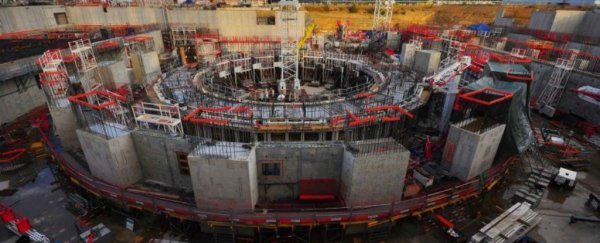The first and largest machine of its kind is currently under construction at the French scientific research centre Cadarache, which specialises in nuclear power research.
It's called ITER, Latin for "The Way", and is expected to usher in a new era of nuclear fusion-powered electricity - something scientists and engineers have been working toward for over 40 years.
By fusing two forms of hydrogen - called deuterium and tritium - together, the machine would generate 500 megawatts of power. That's 10 times more energy than it would require to operate.
Once completed, ITER would measure 100 feet (30 metres) in diameter and height, representing a new breed of nuclear fusion device. If it reaches its energy output goals, it will be the first machine of its kind to bridge the gap from fusion research in the lab to readily available fusion power for cities.
As of June 2015, construction costs for the machine exceeded US$14 billion. But, in the end, experts say it will be worth it. After all, nuclear fusion is the process that powers stars like our Sun and offers a number of advantages to current energy sources if we can harness that power here on Earth:
- Fusion generates non-radioactive waste that can be completely recycled within 100 years, unlike the toxic radioactive residue that today's nuclear fission reactors produce.
- There's no chance of a runaway reaction because any malfunction would halt the fusion process, meaning that fusion reactors don't run the risk of a nuclear meltdown.
- It's a clean source of energy compared to coal, natural gas, and crude oil.
- Fusion reactors can run on seawater, offering a relatively renewable source of energy.
The problem with fusion
Right now, the biggest one is this: Fusion machines in operation today use more energy to run than they put out, which is the exact opposite of what you want from a power plant.
The problem stems from the super-heated plasma that machines, called tokamaks, produce and where the fusion reactions takes place. Below is a schematic of the plasma, shown in purple:
 Matthias W Hirsch/Wikimedia
Matthias W Hirsch/Wikimedia
While reaching these temperatures is a feat of engineering in and of itself, tokamaks can't sustain the plasma flow for very long. The record for the longest sustained plasma is 6 minutes and 30 seconds, which a French tokamak achieved in 2003.
This pulsing behaviour, which comes with turning the plasma repeatedly on and off in short bursts, is what scientists have been trying to bypass for decades because pulsing costs too much energy to be a viable approach for net energy gain.
Instead, the ideal approach is to build a machine that can produce a self-sustaining plasma. That's where ITER comes in. The plasma inside ITER will reach 150 million degrees Celsius, or 10 times hotter than the centre of the Sun and enough to fuse deuterium and tritium.
An important byproduct of the fusion is helium - specifically the nucleus of helium atoms. Once produced, these atoms bounce around, imparting energy in the form of heat, which helps to keep the plasma intrinsically hot, without the aid of additional, external energy input.
"That's how it will be almost completely self sustaining," Jonathan Menard, the program director of a major fusion facility at the Princeton Plasma Physics Lab (PPPL), told Business Insider.
This type of fusion burning is very similar to what's happening in the core of our Sun.
The future of fusion
 Illustration of Wendelstein 7-X's main plasma generator. Science Magazine/YouTube
Illustration of Wendelstein 7-X's main plasma generator. Science Magazine/YouTube
Another machine in Germany called Wendelstein 7-X - which was recently turned on for the first time - is also expected to generate self-sustaining plasma. However, Menard noted that it isn't likely that this machine will generate enough surplus energy to serve as a potential nuclear fusion power plant, which is what ITER is being designed to do.
Still another form of fusion reactors use lasers instead of plasma, like the National Ignition Facility in California, but that area of research still has a ways to go before it can compete with the tokamaks of the world.
"So far, the laser based systems are pretty inefficient an we think the [plasma] fusion systems are closer to having net energy," Menard said.
Construction began on ITER in 2007 and is expected to end in 2019 with the firing of its first plasma in 2020. The machine is expected to reach full deuterium - tritium fusion experiments for potential net energy gain by 2027. In the meantime, fusion research facilities across the globe, like PPPL are exploring different aspects of how ITER will operate.
"Particularly [we're investigating] how well those alpha particles or helium nuclei are confined," Menard said.
Check out a virtual tour through the ITER facility below:
This article was originally published by Business Insider.
More from Business Insider:
